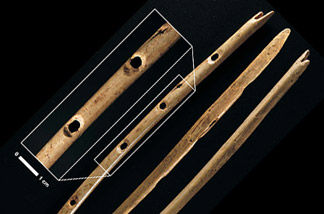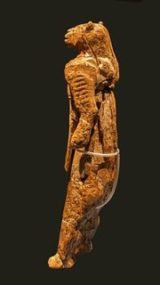Early Music
When musicians or music lovers talk about early music, we’re usually talking about Renaissance music, so roughly between 1400 – 1650, if you extend into the early Baroque. So for us, early music goes back a few hundred years. If you speak to an archaeologist, however, early music takes on a totally different meaning, extending back tens of thousands of years.

Conard, et al. Nature (2009), doi:10.1038/nature08169
Archaeologists have found evidence of cultural and artistic innovations including cave paintings, small human and animal figures, and bone and ivory flutes dating to about 40,000 years ago during the Upper Paleolithic era, about the time that early humans first arrived in Europe.
As difficult as it may be to imagine, stone age humans were playing the flute!
In the summer of 2008, excavations at Hohle Fels in southwestern Germany uncovered one nearly complete bone flute (in 12 pieces) and fragments of two ivory flutes carved from mammoth tusks. The flutes were all dated to about 40,000 years ago. The bone flute, with five finger holes, was made from the hollow bone of a griffon vulture. Researchers also found nearby a small sculpture of a woman carved from mammoth ivory. The excavation was led by archaeologist Nicholas Conard of the University of Tübingen in Germany.
An earlier dig at a nearby site at Geißenklösterle*, also led by Conard, uncovered fragments of two smaller three-holed bone flutes and fragments of an ivory flute dated to 35,000 years ago. As if 35 – 40,000 year-old flutes are not amazing enough, the five-hole Hohle Fels bone flute is in pentatonic tuning. I’m not sure how one even begins to address the significance of that. But we certainly have to change our definition of early music. Instrumental music has been around for tens of thousands of years.**
Wulf Hein is an archaeologist who specializes in the reconstruction of various kinds of prehistoric finds, from small carved figures to a replica of the 40,000 year-old flute. You can hear him speak about and play the Hohle Fels replica in the clip below, taken from Werner Herzog’s 2011 documentary, Cave of Forgotten Dreams.
Importance of music and art for early humans
Several years ago, using the same techniques that prehistoric sculptors would have used, Hein recreated the Lion Man, a 40,000 year-old ivory sculpture discovered in 1939 in a cave in southwestern Germany. The figure is only about 12 in. tall and a little over 2 inches around, but it took him over 400 hours to carve the replica.

He says he stopped counting after 400 hours, so it actually took longer to complete the figure. But during his sculpting hours, he says he realized something very important about that early culture. The main work of the community in prehistoric societies would have been to provide food and shelter, people spending the day hunting, fishing, or gathering edible roots and berries. But Hein suggests that someone, male or female, was freed from those tasks to use their time making this incredible piece of art. Others would have made the bone or ivory flutes.
The construction of the Hohle Fels bone flute shows remarkable creativity. Fine lines were chipped into the bone to ensure that the 5 finger holes would be spaced correctly to ensure the pentatonic tuning. V-shaped notches at the top provided the mouthpiece. (See photo at beginning of post.)
The ivory flutes demonstrate even more advanced technological thinking. The flute makers would have had to carve a straighter tube from the larger curved mammoth tusk, split it and hollow out the two halves, and carve evenly spaced finger holes. Then they cut little notches so the halves would fit together and used some kind of sealant to glue the two halves together.
Other kinds of instruments no doubt existed as well, drums, for example. But the skin used for the head of a drum wouldn’t survive for tens of thousands of years, unlike ivory and bone flutes.
The amount of time (to say nothing of the creativity) necessary to create the pieces of art or the flutes suggests that art and music were integral to this early culture – that they were, and are, in some way fundamental to human nature. The flutes and figurines were also found mixed in with other remnants of daily life, so they were not an “add-on,” they were very much a part of everyday living.
Origins of music
There are many theories about the origins of music. Charles Darwin suggested in the 1870s that music evokes such strong emotions in us because it once served, in evolutionary history, the same function in humans as it did in songbirds, and that is finding a mate. Or in other words, just as food and sex were essential for our stone age ancestors, so was music, so we’ve inherited our compulsion for music.
Other researchers suggest that music was important for bonding between mothers and infants. Mothers would have been using their hands to find and prepare food or do other tasks and therefore used some kind of vocalizations with variations in pitch, rhythm, and timbre, to express emotion and care for infants. This proto-musical language was essential for survival and led to the development of language.
Perhaps the dominant view about the importance of music in pre-literate societies is that it was important for strengthening bonds in a group through a shared emotional experience. We have all experienced the power of live music at an event, whether it is an outdoor rock concert, a symphony hall, or a church. Music brings people together through shared emotional experience.
Archaeologists say that these flutes made tens of thousands of years ago demonstrate that music may have been a way to communicate and bond as a group. And music may have had a ritualistic or religious purpose as well, as the musical instruments are often found in or near caves with paintings in chambers that were large enough to hold groups of people (more on that in the next post). No matter how they were used, music and art appear to have been essential to early humans.
Victor Hugo, the French poet and novelist (1802 – 1885), wrote Music expresses that which cannot be said and on which it is impossible to be silent (from his essay William Shakespeare, 1864). No one knows definitively if there was any kind of rudimentary language 40,000 years ago, but it is clear from the flute discoveries that prehistoric people were not silent. Whatever they were communicating, it involved music.
#####
*There are excellent photos, drawings, and illustrations from Hohle Fels, Geißenklösterle and other archaeological sites in the Swabian Alb at Don’s Maps.
**In his book The Singing Neanderthals, Steven Mithen makes a compelling case for music going back even further – in fact, hundreds of thousands of years – to the early Neanderthals.